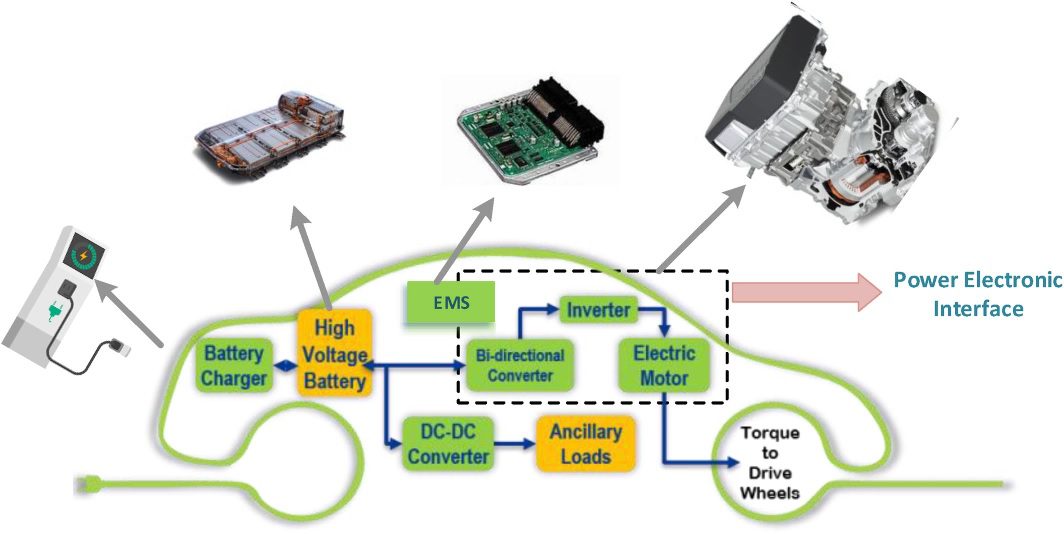Power and Battery Management Systems (BMS) of EVs - 180D-FW-2024/Knowledge-Base-Wiki GitHub Wiki
Introduction
An Automotive Battery Management System (BMS) is the central control system that monitors and manages the battery packs in electric and hybrid vehicles. BMS in general are electronic control circuits that monitor and regulate the charging and discharge of batteries.Its function is to track vital data like voltage, temperature, and current. The BMS uses this information to estimate key metrics like the State of Charge (SOC) and the State of Health (SOH) of the battery. The BMS is also in charge of controlling the Power Distribution Network (PDN). A Battery Management System (BMS) is a crucial component for ensuring the safety, efficiency, and longevity of electric vehicle (EV) batteries. Its main purposes include battery protection, monitoring, and optimization.

Power Distribution Network Control of the BMS
The BMS safeguards the battery by monitoring key parameters like voltage, current, temperature, and resistance to prevent overcharging, over-discharging, overheating, and cell imbalances. It ensures safe operation and provides services like calibration and diagnostics. By estimating the battery's State of Charge (SOC) and State of Health (SOH), the BMS offers accurate data on the remaining driving range and overall battery condition, using techniques like coulomb counting and voltage measurements to improve precision. The BMS also uses cell balancing to maintain even charge levels across all battery cells. This prevents imbalances that can reduce performance or lifespan, enhancing efficiency for hybrid (HEV), plug-in hybrid (PHEV), and full electric vehicles (BEV).
As the communication link between systems, the BMS works with the Vehicle Control Unit (VCU), which manages power delivery. It helps the VCU determine safe power levels for the motor and adjusts energy allocation during acceleration or regenerative braking to optimize performance and efficiency.
The BMS supports thermal management by controlling cooling or heating systems to keep the battery within safe temperatures, ensuring reliable operation in different climates. By integrating these features, the BMS plays a key role in improving EV battery safety, performance, and lifespan.
The illustration below shows how electric energy is utilized throughout the EV.

Current Challenges of Power Management for EVs
Over the last decade, electric vehicles have advanced significantly. Still, challenges remain, particularly in battery management. Key concerns include slow charging, quick battery usage, short battery life, and limited accuracy in monitoring battery health. For instance, the State of Charge (SOC)—a measure of the battery's remaining energy—can be difficult to estimate accurately due to complex battery chemistries and varying environmental conditions. Inaccurate SOC readings can lead to inefficient energy utilization and unreliable range predictions, further fueling range anxiety, where drivers worry about running out of charge before reaching their destination.
The limited energy density of current lithium-ion batteries contributes to shorter driving ranges compared to traditional gasoline vehicles. Efforts to improve charging times, such as introducing chargers capable of delivering 150 kW or more, create additional challenges. Faster charging generates significant thermal and electrical stress, which can cause uneven cell charging, overheating, and accelerated battery wear. Simultaneous fast charging of multiple vehicles also risks straining local power grids, emphasizing the need for smarter BMS integration with energy infrastructure. Thermal management is another critical challenge, as batteries perform poorly in extreme temperatures. Cold climates reduce charging speeds and capacity, while high temperatures accelerate battery degradation. Many BMS systems struggle to maintain optimal performance under these conditions. Additionally, cell balancing remains problematic, as even minor imbalances in cells can lead to uneven wear and reduced battery lifespan.
Addressing these challenges—particularly improving SOC accuracy, thermal control, and cell balancing—will require advanced solutions. However, the cost and complexity of incorporating new technologies, such as high-precision sensors and adaptive algorithms, pose additional hurdles. Overcoming these limitations is essential to improving the reliability, efficiency, and adoption of EVs.
Future Advancements of BMS for EVs
Some methods to improve the Automotive BMS are to further improve the accuracy of SOC estimation, and the influence of temperature and SOH on SOC estimation must be considered. To achieve this, there is a need to develop accurate and adaptive algorithms for precisely estimating the State of Charge (SOC), State of Health (SOH), and State of Power (SOP). Another method to optimize automotive BMS would be to incorporate artificial intelligence (AI) and machine learning algorithms for predictive maintenance and performance optimization. The advancement of Battery Management Systems (BMS) has become a widely discussed and rapidly growing area of focus all around the world. There is a significant increase in demand for electric vehicles, leading to a greater push for better battery performance, safety, and longevity.
The future of Battery Management Systems (BMS) in electric vehicles (EVs) is poised to be shaped by groundbreaking advancements in technology and innovation. One possible direction is the integration of advanced solid-state batteries, leading to higher energy density, faster charging times, and improved safety compared to traditional lithium-ion batteries. The next-generation BMS will leverage advanced sensor technologies to monitor parameters at a granular level, enabling more precise real-time adjustments. The use of blockchain technology for secure data management and communication between EV systems may also become more prevalent, improving reliability and data integrity. In addition, with the rise of connected and autonomous vehicles, BMS will play a key part in enabling vehicle-to-grid (V2G) interactions, where EVs can contribute to stabilizing power grids by storing and returning energy when needed. These advancements will not only address the current challenges we face, but also open new possibilities for more sustainable and efficient EV ecosystems.
References
https://batteryuniversity.com/article/bu-908-battery-management-system-bms https://www.ultralibrarian.com/2023/07/18/battery-management-system-for-electric-vehicles-ev-ulc https://www.powerelectronicsnews.com/the-challenges-of-power-for-the-electrification-of-vehicles/ https://mdpi-res.com/bookfiles/book/3061/Battery_Management_System_for_Future_Electric_Vehicles.pdf?v=1731117725 https://www.monolithicpower.com/en/learning/mpscholar/battery-management-systems/bms-communication-interface/integration-of-bms-communication?srsltid=AfmBOopzWnV9uAl1gPNA6L_p4VPLaNozMGvci_xVBSjagnIqO-bCw75p